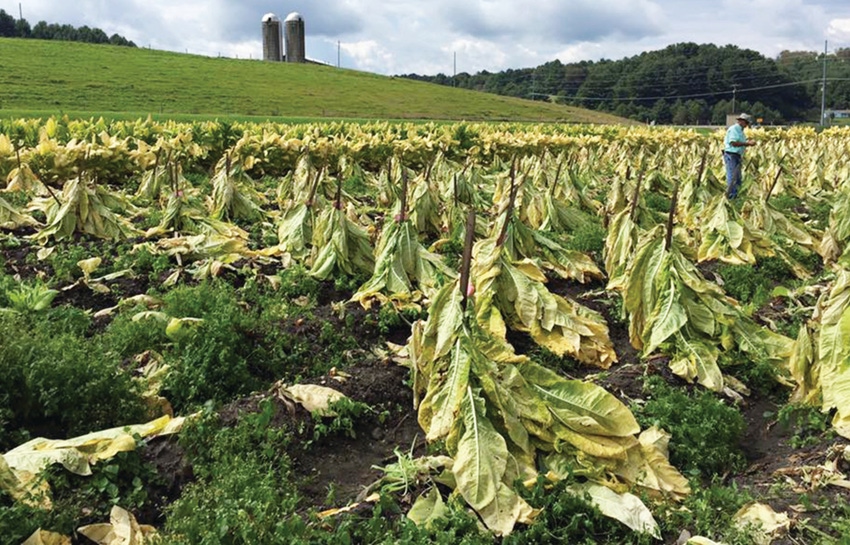January 17, 2018

Ironically, it was a dry spell in September in Kentucky and Tennessee that allowed farmers there to put the final touches on a good burley tobacco crop.
“There was adequate rainfall most of the spring and summer, but it was unusually dry in August and September,” said Jeff Aiken, who grows burley in Telford, Tenn., near Johnson City. “That aided in harvest and barning: We were never once run out of the field because of rain.”
It would, however, have been a little too dry for good curing, he said. “But in mid-October there was a significant change as we went from dry to wet. There was adequate rain, and with moisture in the air, farmers were better able to get the desirable color.”
Some growers were still harvesting in mid-October or later, but Aiken put the last of his tobacco in the barn on Oct. 6. Even that was a little later than what he aimed for.
“Typically, we like to be finished by Oct. 1,” he said. “Any time after that, there is some jeopardy of early frost.”
But his luck held out and there was no frost at his place in east Tennessee before Oct. 6. “The first significant frost didn’t come until the last week of October,” he said.
In Kentucky, as in Tennessee, the weather in September helped in getting the crop finished.
“We had a favorable stretch of weather to get the last of the crop in,” said Bob Pearce, Kentucky Extension tobacco specialist.
Curing went well for the tobacco that was harvested early. But there was a threat to later-harvested burley if temperatures were to turn downward in November.
“An average of 60 to 90 degrees is ideal for curing,” said Pearce. “If it is lower, you run the risk of curing green.”
Labor shortage
The favorable weather late in the season allowed some farmers to sidestep the effects of a labor shortage, because they were able to make maximum use of the workers they had.
But the labor problem hasn’t gone away, says Aiken, who is president of the Tennessee Farm Bureau Federation.
“The work force realistically available for tobacco production is an issue every year. Farmers are looking for labor to accomplish the tasks pertaining to tobacco.”
There are essentially two options.
“Either you find legal workers in the U.S., or you turn to the H-2A program,” he said. “There are problems with that program, but for many farmers it will be the only option available.”
Balanced supply
The supply-demand picture has definitely changed for burley. Since 2014, burley growers worldwide have been suffering from an overall over-supply of burley, said Daniel Green, CEO. of the Burley Stabilization Corporation in Springfield, Tenn.
“We have (now) witnessed an improvement toward a more balanced supply and demand for burley,” he said. “Unfortunately, this improvement is not because of stronger demand, but rather the result of growing challenges in some production areas around the world.”
In Africa, growers faced significant weather challenges in several countries in recent years and had much lower volumes of production, he said. “For instance, Malawi, the world’s largest producer of burley, ended up producing nearly 40 percent less this year than last.
“Additionally, much of the prior-crop inventories in South America and Africa have now been sold, resulting in a much better opportunity from the supply side.”
While production levels in other countries affect the short-term opportunities for burley producers in the USA, the overall decline in demand for burley will continue in the long-term, due to reductions in cigarette sales.
But while the market is getting smaller, it still remains quite large with more than 5.5 trillion cigarettes to be consumed worldwide in 2017, Green said. “Besides the weather, which is never predictable, much of the uncertainty in the long-term outlook for burley hinges on government regulations of the industry.”
Perhaps the most concerning recent news was from the United States Food and Drug Administration (FDA), Green said. At the end of July, the FDA announced a new plan to regulate nicotine in cigarettes to “non-addictive levels,” which would eventually reduce nicotine levels in cigarettes by 90 percent or more.
At the same time, it would implement regulations that encourage smokers to switch to new electronic nicotine delivery devices, such as electronic cigarettes, vaporizers, and heat-not-burn products. “This is a policy shift that will significantly affect growers as other regulatory bodies around the world follow suit,” he said.
Smoke-free future?
Additionally, one of the world’s largest companies has been talking about creating a “smoke-free future” by encouraging its customers to stop smoking and switch to smoke-free products.
“It is still unclear how the adoption of the heat-not-burn products will impact producers of flavor burley like that grown in the USA,” said Green. “But the prospects are certainly more positive compared to vapor products, since much more tobacco leaf is used in the production of heat-not-burn products.”
Where does all this leave burley growers for the 2017 marketing season? “While the long-term outlook remains uncertain, the burley market is definitely in a more balanced position than it was at this time last year,” he said:
The 2017 USA burley crop will likely end up in the range of 150 million to 160 million pounds, just over 13.5 percent of total world production.
World production of burley should total just over 1.1 billion pounds, more than 15 percent less than 2016.
Approximately 1.2 billion pounds of burley are currently needed worldwide to satisfy demand, resulting in a slight, short-term shortage.
“To be sure, African volumes will rebound quickly, and any shortage that results in increased sales of flavor burley should be satisfied by the end of 2018,” he concludes
About the Author(s)
You May Also Like




